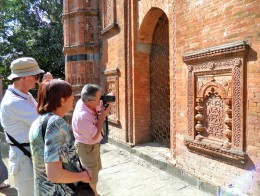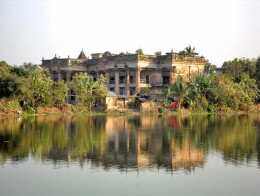Puthia
Situated 20km west of Rajshahi it is an upazila in Rajshahi district. Puthia Jamindari created by the Mughals in the early 17th century is one of the oldest estates of Bengal. The 1895 two storied Puthia Rajbari is one of the most attractive structures in the area. Among others the five spire Govinda temple, Trio Bangla temple, and the Shiva temple of South Indian Style are interesting.
Gaud
Gaur is one of the largest medieval cites in the Indian subcontinent, was the capital of Bengal from 1450 AD to 1565 AD. Located on the eastern strip of land between the Ganges and the Mahananda rivers, has few structures standing inside the border of present day Bangladesh. Choto Shona Mosque, Darashbari Mosque & Madrassa, and Khania Dighi Mosque are some of the remains.
Varendra Research Museum
Varendra Museum was the first museum to be established in erstwhile East Bengal in 1910. The museum started out as the collection for Varendra Investigation Society and got its current name in 1919. Since inception this museum has actively searched and researched history of the ancient Varendra Civilization. Excavation at Somapura Bihara was started by the society along with Calcutta University in 1923. In 1964, the museum became a part of Rajshahi University. The museum has a very rich collection of ancient stuffs from different parts of Bangladesh.
Mahasthangarh
Mahasthangarh is so far the oldest and largest archaeological site of Bangladesh, lies on the western bank of river Katatoya, about 12 km north of Bogra town, and is connected by a good metalled road. The site consists of the ruins of the ancient city of Pundranagara. The city was identified in 1879; the first regular excavation was conducted at the site in 1928-29 by the Archaeological Survey of India under the guidance of KN Diksit. Currently the Bangladeshi and French archaeologists have been carrying out excavation every winter since 1993.
Latest findings indicate a total of 18 building levels and that the city was inhabited as early as 6th Century BC. Dwellers of the city were mainly traders, who traded to and from faraway countries. Allegedly the city was derelict after a great fire in the 15th Century, and had gone underground in few centuries. Govinda Bhita, Laksmindar Medh, Bhasu Vihar, Vihar Dhap, Mangalkot and Godaibadi Dhap are excavated sites located outside the city but within its vicinity. The site has an adjacent museum that houses findings of the city.
Paharpur
Paharpur, an important archaeological site in Bangladesh, is situated in a village in the Badalgachhi Upazila of Naogaon district. The site was first noticed by Buchanon Hamilton in course of his survey in Eastern India between 1807 and 1812. But regular and systematic excavation was jointly started here in 1923 by Archaeological Survey of India, Varendra Research Museum of Rajshahi and Calcutta University.
Excavation unearthed a Buddhist monastery that was built during the period from 780 AD to 830 AD by Dharma Pala, the second king of Pala Dynasty. The site comprises of a nearly rectangular surrounding wall with minor structures like refectory hall, kitchen, well, small Stupas etc, and a central Stupa. The stupa has a cruciform foundation for a hollow chamber supported by four identical wings in four directions. The site has an adjacent museum that houses findings in the surrounding.
Kantanagar Temple
Kantanagar Temple is an eighteenth century brick temple, situated about 12 miles north of Dinajpur town. This originally ‘nine spired’ Hindu temple is said to be the most ornamental temple in Bangladesh. It had lost the spires during the devastating earthquake of 1897. The whole temple is covered with terracotta plaques that describe stories of ten incarnations of Lord Visnu especially from the epic poems Ramayana and Mahavarata.
Tajhat jamindar Palace
This 20th Century palace was constructed by the local Jamindar, and was used as residence till 1950s, when government acquisitioned the estate. In the 1980s, Bangladesh Government used it as the local sit for the high court division of the Supreme Court. Later in the 1990s, shifting the high court, it was given to the archaeological authority that established a small museum on the first floor of the building. With a wide green belt around the building, it makes a good pastime for the tourists.













